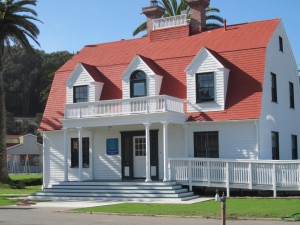
NOAA’s Gulf of the Farallones National Marine Sanctuary opened its new Ocean Climate Center at its headquarters in San Francisco.
The Ocean Climate Center will communicate and facilitate the exchange of technical, scientific, policy and education information and ideas related to ocean and climate change in the Bay area.
The Center will bring together a diversity of knowledge and expertise amongst several federal, state, and local agencies and other academic and non-profit partners to identify, assess and address the effects of climate variability and change on the sanctuary and the surrounding marine region from Sonoma to Santa Cruz County. Staff at the new Ocean Climate Center will work collaboratively with NOAA’s world-renowned climate scientists and experts and eventually with NOAA’s proposed Climate Service once established. The center will also help catalyze the development of information and outreach programs to help inform the public about how climate variability and change may affect ocean ecosystems.
“This center strives to understand the linkages between climate change and ocean ecosystems,” said Margaret Spring, NOAA chief of staff. “This NOAA center — the first of its kind — draws expertise from across the agency’s climate, weather, research, coastal, and fisheries programs, using a place-based approach with federal, state and local partners. We’re pleased that by locating this center in a national marine sanctuary, it can foster a strong connection between the public and the wildlife and marine resources that are naturally linked to a changing climate. It will promote the Northern California region as a study area for the effects of climate change and serve as a model for climate change investigations and solutions nationally.”
The Farallones Sanctuary will use the center to promote partnerships within the greater San Francisco Bay and Northern-Central Coast area to share resources and knowledge and to work together to address this and other effects of climate change in the region.
Today’s ribbon-cutting ceremony also featured several agencies signing a Letter of Intent to collaborate on climate change issues within the San Francisco Bay Area region. Participants include Gulf of the Farallones National Marine Sanctuary, San Francisco Bay National Estuarine Research Reserve, Golden Gate National Recreation Area, Point Reyes National Seashore, San Francisco Bay National Wildlife Refuge and the U.S. Geological Survey. This partnership will function as a subcommittee of the larger Bay Area Ecosystems Climate Change Consortium, made up of federal, state and non-governmental research, management and planning agencies in the San Francisco region working to identify and address climate change impacts by using science to inform adaptive management for long-term ecological and economic benefits.
Also announced today was the first joint project of this consortium, “Preparing for sea level rise along the San Francisco Bay Area’s outer coast.” As defined by a stakeholder participatory process, Farallones Sanctuary, US Geological Survey, and PRBO Conservation Science will assess coastal vulnerability to sea level rise and extreme storm events along the Bay Area’s outer coastline, and develop a web-based decision support tool and interactive maps for local resource managers, planners, and decision-makers. As a result of this project, managers and municipalities will be able to develop informed adaptation and response strategies for anticipated impacts, as well as use this information for planning and management decisions such as: the siting and relocation of infrastructure, design of habitat restoration projects, and the designation of protected habitat.
Climate variability and change are impacting our society and the environment. Commerce, public health, natural resources and major economic sectors, such as water utilities, energy, transportation, agriculture, forestry and fisheries are highly sensitive to climate influences. To more effectively meet the rising public and private demand for climate products and services, Commerce Secretary Locke announced back in February the intent to establish a new NOAA Climate Service and to hire six new regional climate services directors.
The new regional climate services directors are employees of NOAA’s National Climatic Data Center and will work to build and strengthen regional partnerships to better assess and deliver regionally-focused climate science and information products and services to help people make informed decisions in their lives, businesses and communities. Each region is led by a regional climate service director based at one of the six National Weather Service regional offices. DeWayne Cecil, the Western Region director, was at the opening and will be responsible for coordinating Climate Services in the West with the new Ocean Climate Center.
Designated in 1981, Gulf of the Farallones National Marine Sanctuary encompasses nearly 1,300 square miles of ocean and coastal waters beyond San Francisco’s Golden Gate. The sanctuary supports the largest breeding seabird rookery in the contiguous United States and other sensitive species such as whales, sea turtles and white sharks.